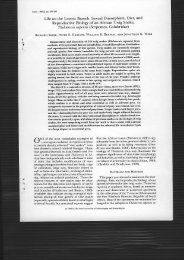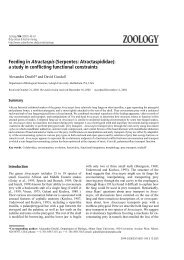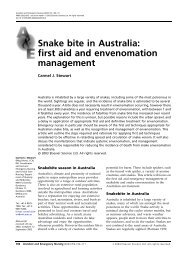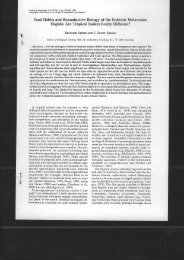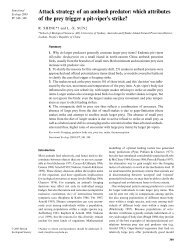Introduction - Kingsnake.com
Introduction - Kingsnake.com
Introduction - Kingsnake.com
Create successful ePaper yourself
Turn your PDF publications into a flip-book with our unique Google optimized e-Paper software.
Clinical Management of Snakebite in Papua New Guinea Chapter 1<br />
Trobriand Islanders believe that some snakes are sacred and either house the spirits of great<br />
chiefs, or are their reincarnations. All the same, finding such as snake in a village was not<br />
considered a good sign, and unless the creature could be tempted to leave with prayers or<br />
other offerings, sudden illness was likely to befall the entire <strong>com</strong>munity. Despite this dreadful<br />
possibility, it was taboo to kill the snake, as this would only make the consequences worse.<br />
The Bariai of West New Britain tell the tale of Moro, a snake-man who started the tradition of<br />
pig exchanges and other ceremonies in honour of firstborn children, and to give praise to the<br />
dead. Legend has it that Moro’s father Kamaia had been killed in a disagreement with his<br />
brothers-in-law, and his liver cut out and cooked. Later during his funeral Moro was tricked<br />
into eating some of the liver by his cousin-in-law Kaukave whereupon his two legs<br />
immediately became fused together and the entire lower half of his body was transformed into<br />
that of a snake. Moro’s transformation is ascribed to the vengeful punishment of his father’s<br />
ghost for the having consumed the liver, albeit unknowingly. Pursued by the ghost of his<br />
father, Moro and his mother escape after Moro uses magic to carve out the Amara River, and<br />
then tricks the ghost into trying to cross, only to be eaten by a large crocodile!<br />
Distinctions between different types of venomous snakes are made by many of the people<br />
living in southern PNG although different names may sometimes be used by different clans of<br />
the same language groups for exactly the same snake, and other groups use just one name to<br />
describe different venomous snakes:<br />
Papuan taipan (Oxyuranus scutellatus canni)<br />
Moveave (Gulf)<br />
Mekeo (Central)<br />
Motu-Koitabu (Central)<br />
Keakalo (Central)<br />
Lavai – ‘black snake with a red stripe that lives in long grasses<br />
Auguma – ‘black snake that bites again’<br />
Kabagi – ‘red snake’ by the people of Barune<br />
Larana Karo – ‘long blacksnake’ by the Barune people<br />
Duba – dark coloured snake by the Kila Kila people<br />
Relena Gamara – ‘big brown snake’<br />
Papuan blacksnake (Pseudechis papuanus)<br />
Moveave (Gulf)<br />
Mekeo (Central)<br />
Motu-Koitabu (Central)<br />
Keakalo (Central)<br />
Mito – ‘black snake that lives in Sago swamps’<br />
Auguma – ‘black snake that bites again’<br />
Larana Karo – ‘long blacksnake’ by the Barune people<br />
Duba – dark coloured snake by the Kila Kila people<br />
Gelema rupa – ‘black snake’<br />
Death adder (Acanthophis spp.)<br />
Mekeo (Central)<br />
Motu-Koitabu (Central)<br />
Keakalo (Central)<br />
Afi – ‘sharp-eyed snake’<br />
Asenamo Api or just Api – ‘short sharp-tailed snake’<br />
Vanaame – ‘short snakes that jumps’<br />
Neither the Mekeo nor Kila Kila Motu people make a significant distinction between taipans<br />
and blacksnakes and use just one name each to describe the two different species. Even the<br />
people of the Moveave region in the east of Gulf province, while using different names to<br />
describe taipans and blacksnakes, identify both as ‘blacksnakes’. The majority of people are<br />
also able to distinguish venomous snakes from non-venomous pythons and other snakes. The<br />
Motu people know pythons as Navara, while their Koitabu cousins use Lavara, and the<br />
Keakalo call large pythons Kapari and may consider some of them sacred spirit animals.<br />
- 1.3 -




